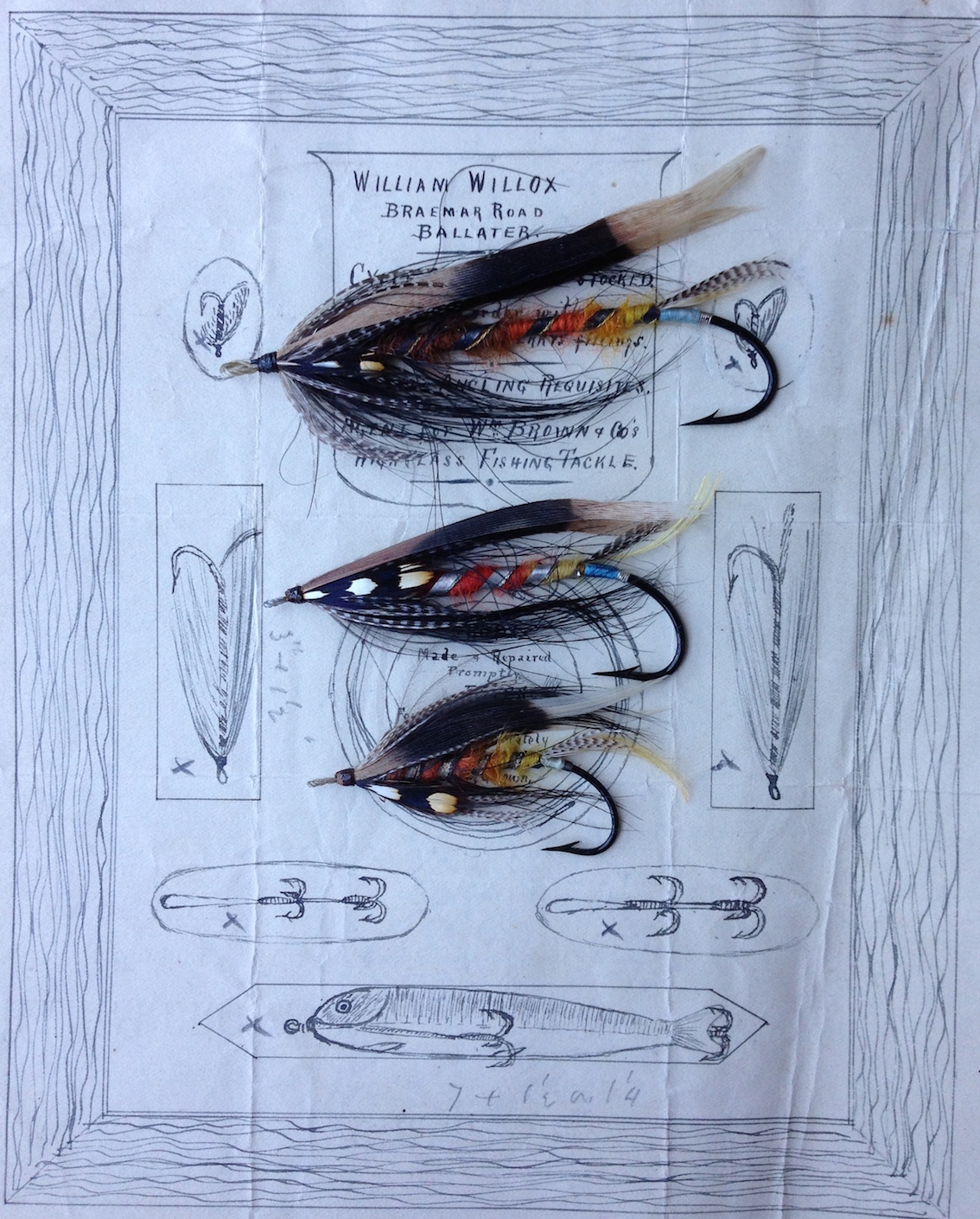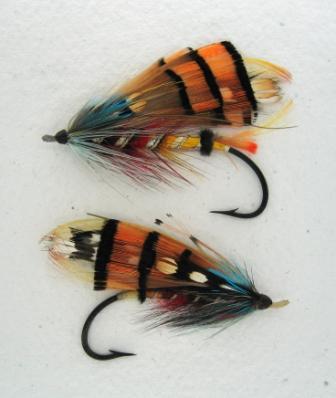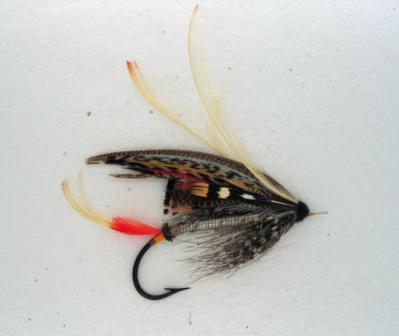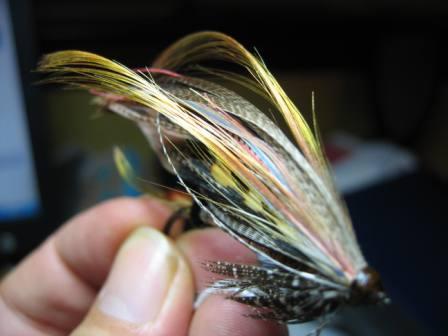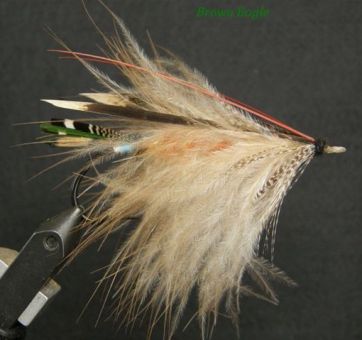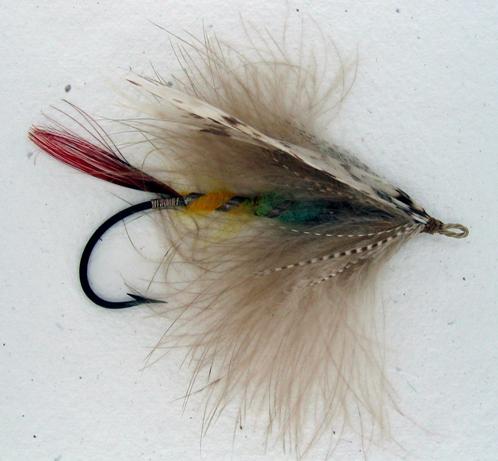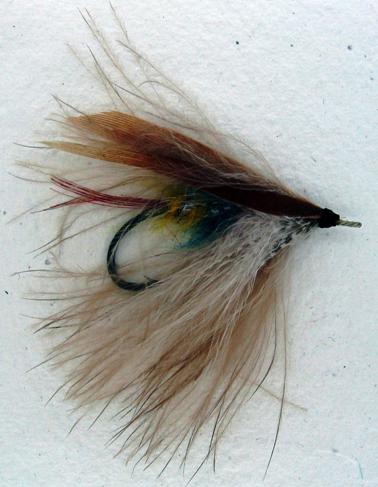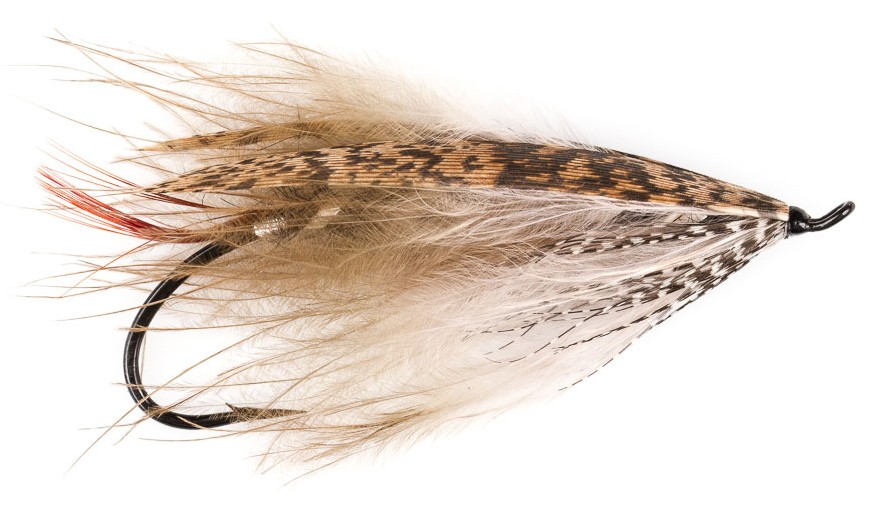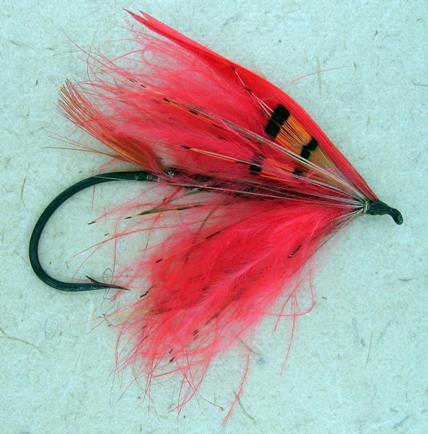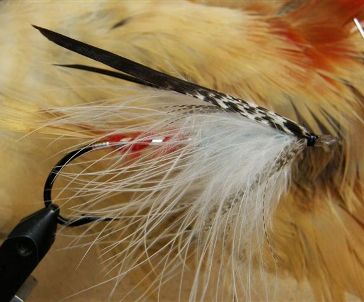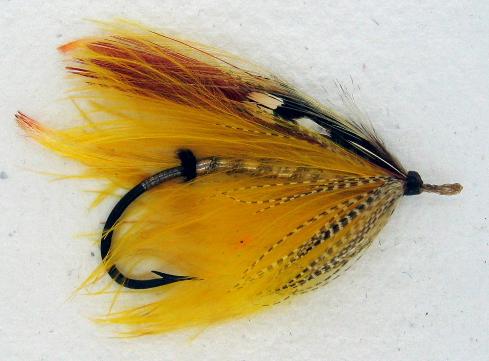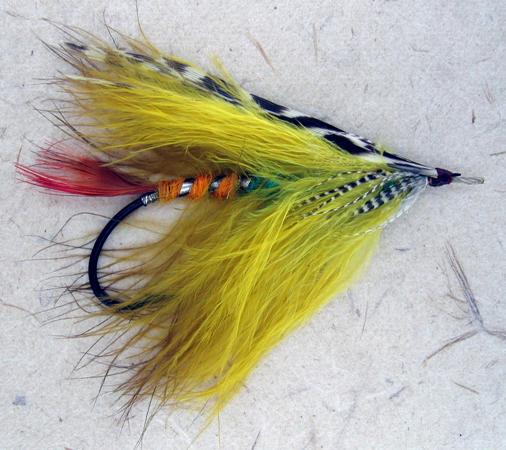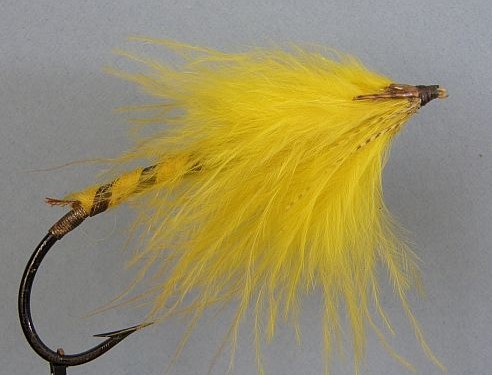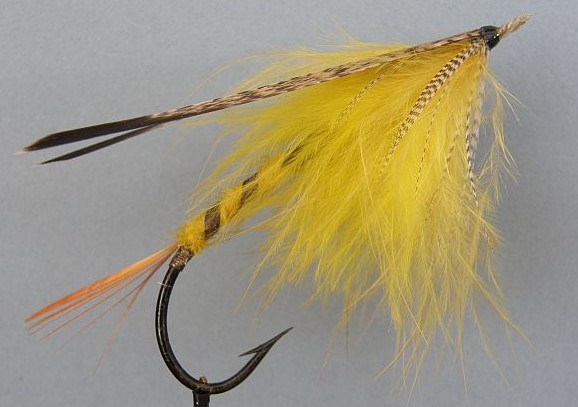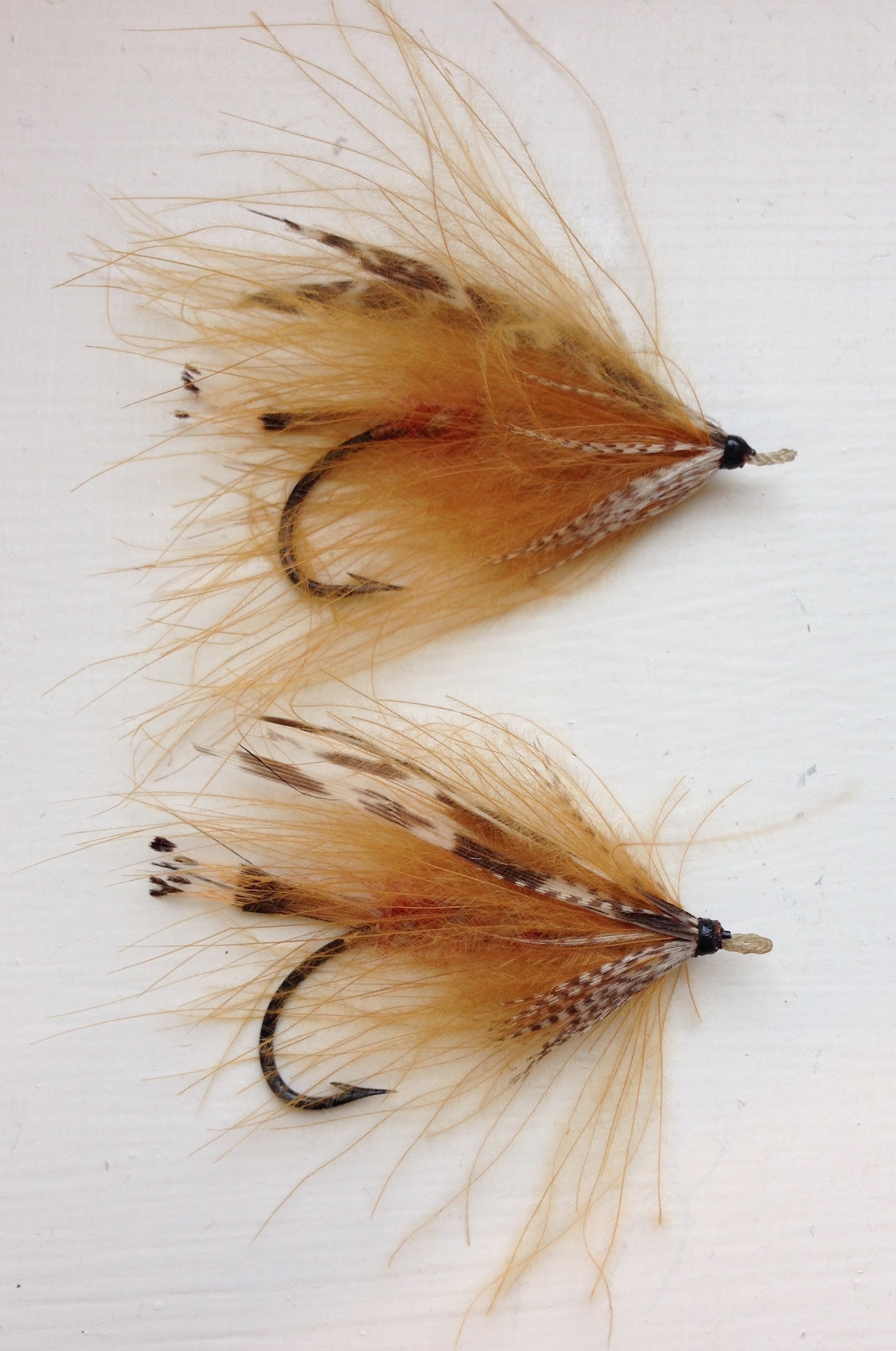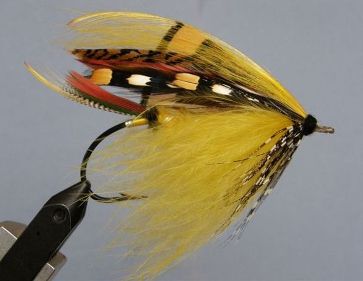 |
 |
|
On this page Dunt, Durham Ranger, Dusty Miller and the Eagle Flies, please scroll down. Dunt
Vintage Dunt with portrait of William Brown as backdrop I think the Dunt is one of the nicer Dee style flies, one night a few months ago I was reading back copies of the Fishing Gazette (I get to do this when I'm working in London as the club I stay at has an almost full set of the fishing gazette - a nice meal a large malt and settle down for a couple of hours - bliss!), there is a series of articles called "Famous Fisherman" from the 1880's this one written MAC - who I think may be William Murdoch, I quote the whole lot as you may find it interesting - however if you just want to know how the Dunt was named you only need to read the last paragraph!
Famous Fishermen – William Dawson, of Minonie – Fishing Gazette “A good man can’t be a bad man too.” He is a good man, and so was his father before him. “A capital fisher, a hardy chap, and a straightforward honest fellow,” is the opinion of a brother fisherman of the subject of our present sketch, Mr. William Dawson, professional angler, Minonie, Just now All Writing to us the other day he says: “I have been fishing constantly on the As a “caster” To watch In his own words we may now tell what he thinks of the various kinds of angling. He says, “Worm fishing, I hate it. Prawn, not much better. Devon, not much use on the At the end of the season
WM – Tag: Silver thread and light blue floss. Tail: A topping and spring of pintail. Body: Ribbed: Broad flat silver tinsel and gold twists, five turns. Hackle: Black heron, over the fiery brown only, and so wound on as to give 20 to 25 fibbers. Shoulder: Teal, sparingly. Wings: Brown turkey strips having a rich dark bar and white tip, with a sprig of teal between them on the top. Cheeks: Jungle. Head: Black. Mr. George Smith, Tackle Merchant, Ballater, has a splendid stock of these patterns, most of which are proved killer on all reaches above, and a good many reached below, that place. William Murdoch Tag: Silver thread and light blue floss silk. Tail: A topping and a small quantity of pintail. Body: Ribbed: Silver (flat) tinsel and gold twist in good long spirals. Hackle: From centre of body to shoulder – a fair quantity of long black heron. Shoulder: Teal. Wings: Two strips of dark brown turkey feather with black bar and white tip. To extend flatwise outward from the top of iron, at an angle of from 15 to 20 degrees. On the top between the wings place a narrow strip of pintail. Cheeks: Jungle Head: Black and as small as possible.
Walbran Tag: Sliver thread and pale blue floss Tail, a topping, green and red parrot, and fibres of pintail. Body: Seal’s fur (well picked out), in six intermediate shades from light yellow to fiery brown inclusive, the colour shading into each other and deepening towards the head of the fly. Ribbed: Broad flat tinsel and gold cord. Hackle: Black heron’s of long fibre from a third of the way down the body, teal at the shoulder, with a broad strip of pintail on back of hook, below, and to show between wings. Cheeks: Jungle with two spots. Wings: Two broad slips of dark brown turkey with large black bars and white tips, one at each side, extending from back of fly outward at angle from 20 degrees to 25 degrees. Head: varnished. Walbran quotes Murdoch “The Dunt kills on any river. It is the best all-round fly I ever invented.” One of Mr. Murdoch’s Dee Patterns.
Kelson – The Salmon Fly, 1885 Tag: Silver twist and light blue silk. Tail: A topping and teal. Body: Yellow, orange, red-claret seal’s fur, in equal sections. Ribs: Silver lace and silver tinsel. Hackle: Black heron, from claret fur. Throat: Teal. Wings: Two strips of plain brown turkey with black bars and white tips. Sides: Jungle, short and drooping over throat hackle. In spring of 1893 this pattern accounted from seven Salmon out of the nine caught in the Birnam water on the Mr Murdoch writes: - “There is not a better all-round fly of the plain sort than the Dunt put upon the Kelson – Land & Water Cards c.1902 The ready and practical pen of Mr. W. Murdoch, to whom the angling public is indebted for this admirable Deeside pattern, has been familiar to one and all of us for many long years. Of all the fly inventions by this gentleman I willingly endorse the general opinion that the Dunt takes precedence. I have myself been lucky with it on other waters than the Tag: Silver twist and light blue silk. Tail: A topping and teal. Body: Yellow, orange, red-claret seal’s fur in equal sections. Ribs: Silver lace, and silver tinsel (flat). Hackle: Black heron from claret fur. Throat: Teal. Wings: Two strips of cinnamon turkey with black bars and white tips. Sides: Jungle, short and dropping over throat hackle.
Vintage Dunts 9/0 down Pryce-Tannatt - How to Dress Salmon Flies, 1914 Tag: Silver thread and light blue floss Tail: A topping and a pair of jungle cock feathers (back to back). Body: Yellow, orange and fiery brown seal’s fur in equal sections (dressed thin, but well picked out). Ribs: Flat silver tinsel and twist. Hackle: A black heron’s hackle from third turn of tinsel. Throat: Teal. Wings: A pair of brown turkey tail strips, with black bars and white tips (set flat). Cheeks: Jungle cock (drooping). Hook: 1½ to 3 inches. Hardy – Salmon Fishing, 1907 Tag: Silver tinsel and light blue floss. Tail: A topping and teal. Body: Yellow, orange, red-claret seal’s fur, in equal sections. Ribs: Silver lace and silver tinsel. Hackle: Black heron. Throat: Teal. Wings: Two strips of plain brown turkey with black bars and white tips. Sides: Jungle cock. Head: Black
Durham Ranger
A pair of vintage Durham Rangers Kelson – Land & Water Cards c. 1885 The Durham Ranger was invented about twenty-one years ago by James Wright of Sprouston. The extent of resources in dealing with the conditions appertaining to bright and coloured water are to be equally applauded. For very clear water the composition is marked by high qualities - proportion, transparent brilliance, a power of attracting from a distance, the whole resting upon a basis of irreproachable technique. For coloured water we have here a good pattern, although not nearly as effective as in clear water. The bars across the tippets and the black points of the body hackle show up wonderfully well, whilst “the blue-over-black” (a noted fly for dark water) is distinguishable at the throat and head end of the body. With all that it kills better in open than in shaded pools. It is dressed as follows:- Tag: Silver twist and very dark yellow silk. Tail: A topping and Indian crow. Butt: Black herl. Body: Two turns of dark orange silk, two turns dark red-orange seal’s fur; the rest, which is about half, black seal’s fur. Ribbed: Silver lace and silver tinsel. Hackle: From orange seal’s fur a white coch-y-bonddu dyed orange. Throat: Light blue hackle. Wings: Four golden pheasant tippets overlapping, as illustrated, and enveloping two projecting jungle fowl feathers back to back and a topping. Cheeks: Chatterer. Horns: Blue macaw. Head: Black Berlin wool. Kelson – The Salmon Fly, 1885 Tag: Silver twist and yellow silk. Tail: Topping and Indian crow. Butt: Black herl. Body: Two turns of orange silk, two turns of dark orange seal’s fur; the rest which is about half, of black seal’s fur. Ribs: Silver lace and silver tinsel. Hackle: A white coch-a-bonddu dyed orange, running along the furs. Throat: Light Blue hackle. Wings: Four tippets over lapping (two on each side) and enveloping two projecting jungle (back to back), and a topping. Cheeks: Chatterer. Horns: Blue macaw. Head: Black Berlin wool. Rivers: - Tweed, Spey, Lochy, Pryce-Tannatt - How to Dress Salmon Flies, 1914 Tag: Silver tinsel. Tail: A topping and Indian crow. Butt: Black herl. Body: Lemon floss, orange, fiery brown, and black seal’s fur in equal sections. Ribs: Flat silver tinsel and twist. Hackle: A badger hackle dyed yellow. Throat: A light blue hackle. Wings: A pair of jungle cock feathers (back to back) covered for three quarters of their length by two pairs of tippets (back to back). Sides: Jungle cock. Cheeks: Blue chatterer; a topping over. Horns: Blue and yellow macaw. Hook: 1¼ to 2 inches. Hardy – Salmon Fishing, 1907 Tag: Silver tinsel, yellow floss. Tail: Topping and Indian crow. Butt: Black herl. Body: Two turns of orange floss, two turns of dark orange seal’s fur; the rest black seal’s fur. Ribs: Silver lace and silver tinsel. Hackle: A white coch-a-bonddu dyed orange. Throat: Light Blue hackle. Wings: Four tippets over lapping (two on each side) and enveloping two projecting jungle (back to back), and a topping. Cheeks: Chatterer. Horns: Blue macaw. Head: Black.
Dusty Miller
Vintage Dusty to early pattern (no orange on body) - but check out those GP crests! and here is the dressing that specifies how to tie it that way! Maxwell – Fishing at Home and Abroad, 1913 "Tag: Silver wire. Tail: A topping and Indian crow. Butt: Black chenille. Body: Two thirds embossed silver tinsel, one third gold floss. Ribbed: Flat silver tinsel. Hackle: Wing: Two slices of black turkey with white tip, fibres of bustard, argus pheasant and red, yellow and blue dyed swan over; two jungle-fowl feathers half the length of the wing, and two toppings tied in over all with the curve of the feather directed outwards and upward, instead of being set as usual to curve downwards. The “Dusty Miller” has undergone a change in raiment since I made his acquaintance. The gold floss and orange hackle on the body are a modern innovation, and alter the grey, “dusty” appearance he used to present. However, he remains as good a killer as of old, and is reckoned specially so on the
Another vintage Dusty Miller - showing the construction of the wings - very 3D ! Here is how the Dusty Miller was described WM Tag: Silver twist and yellow floss. Tail: Small topping. Butt: Black herl. Body: Embossed silver tinsel. Ribbed: Silver Flat worm. Wings: Mixed white tipped turkey, pheasant’s tail, pintail, bustard, summer duck, blue, red, and yellow swan, topping all over. Hackle: Guinea fowl, only at shoulder in small specimens. Cheeks: Jungle fowl, small. Head: Black. Limericks, sizes 5, 6, 7, 8, double irons. In the smaller sizes, the silver flatworm and turkey to be omitted. Than this fly, perhaps, no better specimen can be found wherewith to angle on the WM describes this pattern as “an old
Eagle or “aigle”
The Eagle family is a favourite of many, here is a little bit about them. From Francis Francis – A book on Angling, in the section "Mr. Browns patterns" Some of the flies used [on the Dee], as the Eagle (local ‘aigle;’ and here I may say that the Aberdeenshire dialect is the worst and most non-understandable to a stranger of any in Scotland; for, though tolerably experienced, I never could understand half my gillies said when they were conversationally inclined during my visits there) - I say the ‘aigle’ is little more marvellous as a fly than the dialect is as a dialect, and if we might liken some flies to shrimps and prawns, and others to butterflies and dragon flies, the Eagle completely knocks all such possibilities on the head, as it is like nothing on, over, or under the earth. The Eagle - There are two Eagles, the grey and the yellow. The yellow is simply the same feather as the grey, only died a bright canary yellow; indeed, I believe, in the evening, the ‘yellow aigle’ is the favourite, and is the more effective fly of the two. The tail, body, &c., are precisely similar to those of the gled wing; a quantity of the down or fluffy part of the golden eagle’s feather - the part on and above the leg is, I fancy, the best - is then wound on like a hackle, till the fly looks like the but end of a largish eagle’s feather itself; on the shoulder is of course the invariable teal hackle; wings , two broadish strips of silver grey turkey; the large mottled or broad striped and banded feather being selected.
Brown Eagle
Tied by Bob Fransden - using a vintage Eagle feather
William Murdoch Tag: Silver twist and light blue floss. Tail: Green Parrot, summer duck, and fibres of tippet. Butt: Black ostrich. Body: Two turns light brown floss, remainder orange fur. Ribbed: Gold tinsel (oval). Hackle: Dark grey down of the golden eagle - from light brown floss. Shoulder: Teal - sparingly. Wings: Strips of dark brown turkey feather, with white tip extending flatwise outward from the top of the iron at an angle of 15 degrees. Horns: Red macaw. Head: Black wool. The pattern of the excellent spring fly above described is dressed by Mr. Wm. Garden, fishing-tackle maker,
Grey Eagle Tied by Colin Simpson
Vintage - different wing material
Vintage WM Tag: Silver tinsel. Tail: Golden pheasant rump feather. Body: Black mohair well picked out. Ribbing: Broad silver tinsel. Hackle: Grey eagle. Shoulder: Teal. Wing: Mottled turkey wing, brownish tinge. Head: Black.
Tied by Timo Kontio to Murdoch's pattern from the Fishing Gazette Feb 1884 From Walbran's book British Angler 1889, One of Mr. Murdoch’s Tag: silver thread. Tail: Golden pheasant’s red rump feather. Body: Two turns of yellow, three of turkey red, and four of light blue mohair, well picked out. Ribbed: Broad flat tinsel and silver cord. Hackle: Whitish grey eagle (dressed full) down from end of yellow to head, teal at shoulder. Wings: Two broad slips of black and white mottled turkey with black bars and white tip, set outwards as in the Dunt.
Kelson – The Salmon Fly, 1885 Tag: Silver tinsel. Tail: Red breast feather of the golden pheasant. Body: Yellow, light blue, and scarlet seal’s fur. Ribs: Silver lace and silver tinsel. Hackle: Grey eagle, from blue fur. Throat: Widgeon (teal for large patterns). Wings: Two strips of brown mottled turkey, with black bars and white points. A well-known dark water fly on the Pryce-Tannatt - How to Dress Salmon Flies, 1914 Tag: Silver tinsel. Tail: A topping and the tip of a golden pheasant’s breast feather. Body: Light orange, deep orange, scarlet and pale blue seal’s fur in equal sections (dressed thin, but well picked out). Ribs: Flat silver tinsel and twist. Hackle: An eagle’s hackle (one side stripped) from third turn of tinsel. Throat: Widgeon. Wings: A pair of light, mottled grey turkey tail strips (set flat). Hook: 2 to 3 inches. Hardy – Salmon Fishing, 1907 Tag: Silver tinsel. Tail: Red breast feather of golden pheasant. Body: Yellow, light blue and scarlet seal’s fur. Ribs: Silver lace, silver tinsel. Hackle: Grey eagle. Throat: Widgeon. Wings: Two strips of brown mottled turkey with white tips.
Red Eagle
Vintage, from my collection - I'm calling this a Red Eagle, don't know if that is the correct name, the pattern taken from the fly is: Tag: Silver wire Tail: Golden pheasant rump. Body: Red floss. Rib: Silver embossed tinsel, broad. Hackle: Red eagle and tippet in strands. Wing: Red Swan and tippet.
Eagle, White
In a recently published book on salmon flies I have seen the Lady Mary described as the White Eagle - quite why I don't understand - anyway this is the correct dressing for the White Eagle.
WM Tag: Silver tinsel. Tail: Golden pheasant rump feather. Body: red and blue mohair in equal proportions – blue nearest head. Ribbing: Silver tinsel, broad. Hackle: White eagle down – a considerable quantity. Shoulder: Teal. Wings: Black and white turkey. Head: black head.
Yellow Eagle
Vintage Yellow Eagle - Silver Body
Vintage 3 vintage Eagles - complete with the quill protectors that they were sold with to stop them tangling up in the fly box Yellow Eagle tied by Aberdeenshire Chris Western - photograph does not do it justice!
A Yellow Eagle found in an old wallet that Mr Moth had paid a visit to
This is after it visited Dr Bobs Surgery in Australia ! Note that the body is yellow and blue - yet another pattern variation to find
By Lake and River, an anglers rambles in the north of England and Scotland, by Francis Francis - 1874
I have heard many theories as to what the salmon mistakes the usual run of flies for; but for what he can possible mistake a “yaller aigle” (as it is called in those parts) passes my comprehensions utterly. There is nothing like it that I ever saw either in earth, air, or water. These flies are used large in spring and high water, and smaller when the water fines down.
Tag: Silver tinsel. Tail: golden pheasant rump feather. Body: Two turns blue mohair, and two turns claret mohair. Ribbed: Silver tinsel and gold twist. Hackle: A full deep yellow eagle hackle well down body. Shoulder: Teal. Wing: Head: Black. William Murdoch Tag: Silver thread. Tail: Sprigs of tippet, or the red rump feather of the golden pheasant. Body: Scarlet seal’s fur, or yellow and scarlet seal’s fur in equal joints. Ribbed: Silver tinsel and silver cord in good bold spirals. Hackle: From third way down the body, down of the golden eagle dyed a pronounced yellow. The longer and fluffier the fibres are so much the better. Hackle sparse for some rivers, medium for others, but pretty full for most. Wings: Silver spreckled strips of turkey, with black bar and white tip extending flatwise outward at an angle of from 15 to 20 degrees from the top of the iron. Head: Varnished Dressed on Limericks from 1/0 up to 10/0 Pattern from Mr. John Alexander Dunbar, The esplanade, Oban, Argyllshire, gun and fishing tackle maker.
I think these may be examples of the above version from Mr Dunbar - the body is all scarlet
Kelson – The Salmon Fly, 1885 Tag: Silver twist. Tail: Red breast feather if the golden pheasant. Body: Yellow, scarlet, and light blue seal’s fur. Ribs: Silver lace and silver tinsel. Hackle: Eagle dyed yellow, from scarlet fur. Throat: Widgeon (teal, large patterns). Wings: Two strips of grey mottled turkey having black bars and white points. A well-known dark water fly on the Pryce-Tannatt - How to Dress Salmon Flies, 1914 Tag: Silver tinsel. Tail: A topping and the tip of a golden pheasant’s breast feather (best side under). Body: Lemon, bright orange, scarlet and fiery brown seal’s fur in equal sections (dressed spare, but well picked out). Ribs: Broad silver tinsel and twist. Hackle: An eagle’s hackle (one side stripped) dyed yellow. Throat: Widgeon. Wings: A pair of light, mottled grey turkey tail strips (set flat). Hook: 2 to 3 inches.
Eagle, Yellow – Halladale Pattern
Tied by Bob Frandsen
William Murdoch Tag: Silver twist with yellow floss. Tail: A topping, widgeon, and green and red parrot. Butt: Black ostrich Body: Three-fifths light yellow and two-fifths red orange fur, all well picked out. Ribbed: Double oval tinsel (silver). Hackle: Down of the Golden Eagle dyed a bright yellow – from red orange fur. Throat: Guinea Fowl. Wing: Two tippets extending to tag; red and yellow swan and pheasant’s tail; jungle on either side – full length of wing; gold colour mohair on top, and topping over all. Cheeks: Jungle. Head: Black wool, or varnished. The Yellow Eagle is a fly widely and favourably known, as almost wherever it has been tried it has proved to be a “killer.” Cast on a discoloured or high running it is very effective on the best rivers in the far north, as also on the Spey, the Don, and the Aberdeenshire Dee. Pattern of the Halladale Eagle (above described) received from Mr. John Alexander Dunbar, gun and fishing tackle manufacturer, Oban, N.B.
|
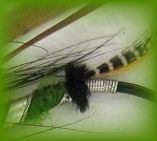
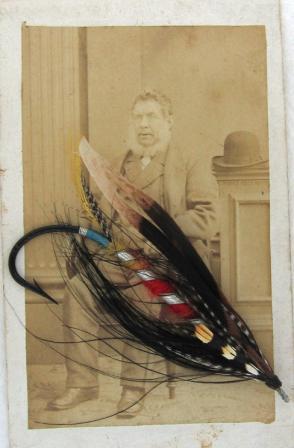
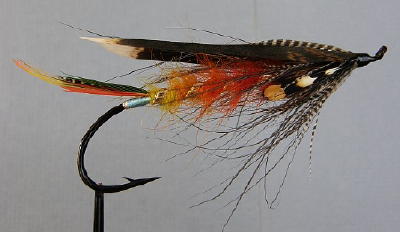
.jpg?957)
